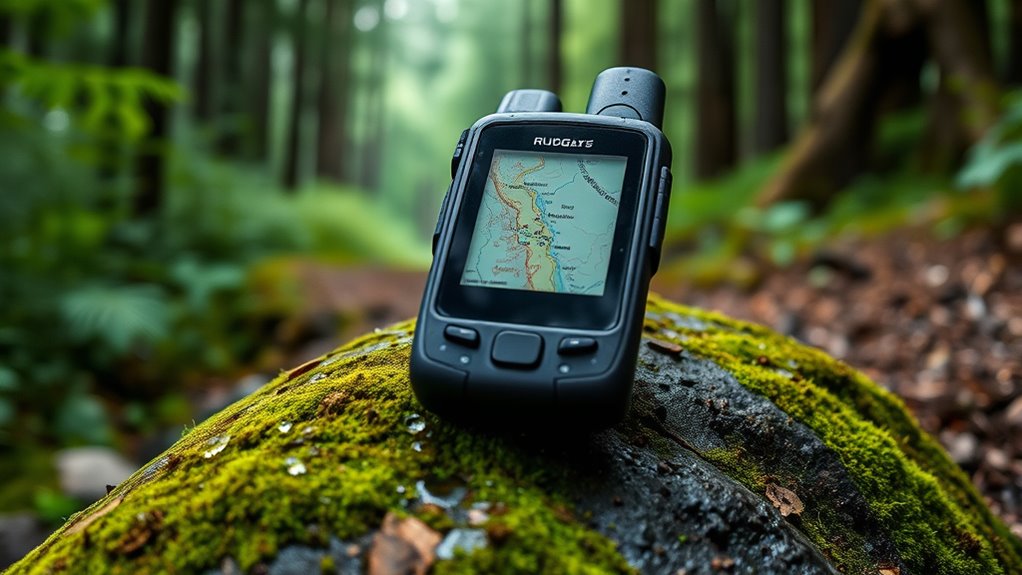If you’re looking for dependable rugged GPS handhelds that can handle tough environments and guide you anywhere, I’ve found the best options for durability, accuracy, and functionality. From models like Garmin Montana 700, eTrex 22x, and GPSMAP 67 to specialized surveying devices like ZL190PLUS, these units offer strong build quality, multi-satellite support, long battery life, and clear displays. Keep an eye out—what I share next will help you choose the perfect device for your adventures.
Key Takeaways
- These rugged GPS handhelds are built to withstand harsh environments with MIL-STD and IP ratings.
- They feature large, sunlight-readable screens with glove-friendly controls for outdoor visibility.
- Support multi-band GNSS and preloaded topographic or marine maps for precise navigation.
- Designed for long battery life, suitable for extended outdoor adventures and challenging terrains.
- Durable construction, water resistance, and shockproof design ensure reliability in extreme conditions.
Handheld GPS Survey Equipment for Land Surveying

Are you looking for a reliable handheld GPS device for large-scale land surveying? I’ve found one that features a 3.2-inch HD anti-glare TFT screen with backlight, making it easy to read in any environment. It supports multiple measurement modes—area, distance, slope—perfect for terrains like farmland and parking lots. Powered by four satellite systems, it offers pinpoint accuracy within ±0.002 acres, ideal for large fields. Its rugged, waterproof, dust-proof design withstands tough conditions. Lightweight and portable, it’s easy to carry around. While it’s great for big areas, it’s less precise for small plots and doesn’t include elevation data, so keep that in mind.
Best For: land surveyors and outdoor professionals requiring durable, high-precision GPS tools for large-area measurements in rugged environments.
Pros:
- Supports multiple satellite systems (GPS, BEIDOU, GLONASS, QZSS) for enhanced signal accuracy.
- Robust, waterproof, and dust-proof design suitable for tough outdoor conditions.
- Portable with a clear, anti-glare 3.2-inch HD screen for easy reading in various lighting environments.
Cons:
- Less accurate for small plots under 1/4 acre due to potential measurement variability.
- No elevation or altitude data included, limiting precise vertical measurements.
- User feedback indicates possible inconsistencies in measurement stability and unclear device orientation requirements during use.
Wearable4U Garmin Montana 700 Rugged GPS Navigator

The Wearable4U Garmin Montana 700 Rugged GPS Navigator is an ideal choice for outdoor enthusiasts who need a durable, reliable device that can withstand harsh conditions. With a 5-inch glove-friendly touchscreen, it’s larger and easier to read in the field. Built to MIL-STD 810 standards, it resists thermal shocks, water, vibration, and shocks. Supporting multiple GNSS systems and preloaded TopoActive maps, it offers accurate navigation. Features like a 3-axis compass, barometric altimeter, and up to 18 hours of battery life make it perfect for extended adventures. Its rugged construction guarantees it remains functional in extreme environments, making navigation straightforward and dependable anywhere you go.
Best For: outdoor enthusiasts and adventurers who need a rugged, reliable GPS device with long battery life and detailed navigation features for challenging environments.
Pros:
- Durable construction meets MIL-STD 810 standards, resistant to water, shocks, and vibration
- Large, glove-friendly 5-inch touchscreen with excellent outdoor visibility
- Supports multiple GNSS systems and preloaded TopoActive maps for accurate navigation
Cons:
- High cost of accessories and optional add-ons
- Mixed reviews on user interface usability and slow performance in some tasks
- Connectivity issues reported, particularly with Bluetooth pairing and touch responsiveness

If you need a reliable GPS device that can withstand tough outdoor conditions, the Garmin eTrex 22x is an excellent choice. Compact and rugged, it features a sunlight-readable color display and supports dual GPS and GLONASS satellites for improved tracking. Its waterproof design and sturdy build make it durable in harsh environments. Powered by 2 AA batteries, it offers up to 25 hours of use. Preloaded with topo maps and expandable via microSD, it’s perfect for hiking, surveying, or off-road adventures. Simple to operate with physical buttons and a toggle stick, it’s trusted by outdoor enthusiasts for accuracy and reliability.
Best For: outdoor enthusiasts, hikers, and professionals needing a durable, reliable GPS device for rugged environments.
Pros:
- Rugged and waterproof IPX7 design suitable for harsh conditions
- Supports dual GPS and GLONASS for improved accuracy and tracking in challenging environments
- Long battery life of up to 25 hours with simple operation via physical buttons and toggle stick
Cons:
- Limited connectivity options, lacking Bluetooth and Wi-Fi for wireless data transfer
- Outdated microUSB port instead of modern USB-C for charging and data transfer
- Small display size and lower resolution may make detailed map reading and trail differentiation difficult
Garmin eTrex 32x, Rugged Handheld GPS Navigator

For outdoor enthusiasts who need a durable and reliable GPS device, the Garmin eTrex 32x stands out as an excellent choice. Its rugged design, combined with a sunlight-readable 2.2-inch color display, ensures clear visibility in all conditions. Preloaded with Topo Active maps and capable of supporting additional maps via micro SD, it’s perfect for hiking and cycling. Dual-satellite support (GPS and GLONASS) boosts accuracy in tough environments. With a 3-axis compass, barometric altimeter, and up to 25 hours of battery life using AA batteries, it’s built to last and perform dependably during extended adventures.
Best For: outdoor enthusiasts seeking a durable, easy-to-use GPS device for hiking, cycling, and trail navigation in challenging environments.
Pros:
- Rugged design and durable build suitable for outdoor use
- Sunlight-readable 2.2-inch color display for clear visibility in all lighting conditions
- Supports multiple satellite systems (GPS and GLONASS) for increased accuracy in tough environments
Cons:
- User interface can be non-intuitive and difficult to navigate for beginners
- Software updates via Garmin Express are slow and sometimes problematic
- Limited connectivity features, lacking Bluetooth and mobile app synchronization
Garmin GPSMAP 67 Rugged GPS Handheld

Outdoor enthusiasts who need a reliable, durable navigation tool will find the Garmin GPSMAP 67 to be an excellent choice. This rugged handheld features a large 3-inch sunlight-readable color display, perfect for outdoor conditions. It’s waterproof, impact-resistant, and built to handle harsh environments. With advanced sensors like a 3-axis compass and barometric altimeter, it provides all-encompassing navigation. Its multi-band GNSS and support for multiple satellite systems ensure quick, accurate positioning—even in dense forests or urban areas. The device offers up to 180 hours of battery life, supports detailed maps, satellite imagery, and wireless connectivity, making it ideal for extended adventures.
Best For: outdoor enthusiasts and adventurers seeking a rugged, highly accurate GPS device for extended outdoor activities in challenging environments.
Pros:
- Extremely durable and waterproof design suitable for harsh conditions
- Long battery life lasting up to 180 hours in standard mode
- Supports multiple satellite systems and multi-band GNSS for precise positioning
Cons:
- Complex user interface may require time to master
- Higher price point compared to basic GPS devices
- Large size may be less convenient for casual or lightweight use
Garmin GPSMAP 79sc Marine GPS Handheld

Looking for a durable GPS device that can handle harsh marine environments? The Garmin GPSMAP 79sc is built for that, with a rugged, floating, water-resistant (IPX6) design. It features a high-res color touchscreen, scratch-resistant fogproof glass, and supports multiple satellite systems for reliable tracking. It’s lightweight at just 9.9 ounces and includes a built-in electronic compass and barometric altimeter for precise navigation. With storage for 10,000 waypoints and detailed BlueChart g3 coastal maps, it’s perfect for marine adventures. Despite a complex menu system and some map upgrade costs, its durability and reliable performance make it a top choice for boating, kayaking, or fishing in tough conditions.
Best For: outdoor enthusiasts, boaters, and anglers seeking a rugged, reliable GPS device for marine environments.
Pros:
- Durable, water-resistant (IPX6) and floats, ideal for harsh marine conditions
- Supports multiple satellite systems (GPS, GLONASS, Beidou, Galileo, QZSS, SBAS) for accurate global tracking
- Large storage capacity with 10,000 waypoints and detailed BlueChart g3 coastal maps
Cons:
- Complex, non-intuitive menu system requiring time to learn and customize
- Additional costs for map upgrades (~$100 per chart) and fiddly micro-SD card handling
- Screen visibility can be challenging in bright sunlight, despite good light conditions
Garmin Montana 700 Rugged GPS Handheld

The Garmin Montana 700 stands out as an ideal choice for adventurers who need a durable, reliable GPS device in tough environments. Its rugged construction, rated MIL-STD 810, ensures it can handle thermal shifts, shocks, water, and vibration. With an IPX7 water resistance rating, it’s perfect for outdoor activities like hiking or kayaking. Despite its tough build, it’s lightweight at just 14.6 ounces, making long treks more comfortable. The 5-inch glove-friendly touchscreen offers clear, responsive navigation in sunlight. Whether you’re off-road, on water, or in the mountains, this device is built to withstand demanding conditions and keep you on track.
Best For: outdoor enthusiasts, hunters, and adventurers seeking a rugged and reliable GPS device for challenging environments.
Pros:
- Extremely durable with MIL-STD 810 and IPX7 ratings, suitable for harsh conditions
- Large 5-inch glove-friendly touchscreen with high visibility in sunlight
- Supports multi-GNSS for precise navigation in difficult terrains
Cons:
- Limited internal storage of only 32GB, which may require additional SD card space
- Occasional software bugs and stability issues reported by users
- Heavier than some competing models at 14.6 ounces, which may affect long-term comfort
Garmin GPSMAP 79s Marine GPS Handheld

If you need a durable, waterproof GPS device that can handle rough marine conditions, the Garmin GPSMAP 79s Marine GPS Handheld might be exactly what you’re looking for. It’s rugged, floats, and resists water (IPX6). The high-res color display is sunlight-readable and scratch-resistant, perfect for outdoor use. Powered by 2 AA batteries with up to 20 hours of life, it supports multiple satellite systems for reliable tracking. While its interface feels old-fashioned and navigation can be tedious, it’s accurate, reliable, and great for backup or casual marine navigation. Its sturdy design and map flexibility make it a solid choice for tough environments.
Best For: outdoor enthusiasts and boaters seeking a rugged, waterproof handheld GPS for reliable navigation in tough marine conditions.
Pros:
- Durable, waterproof design that floats and resists water (IPX6)
- Supports multiple satellite systems for accurate global tracking
- Long battery life of up to 20 hours in optimal conditions
Cons:
- Outdated, unintuitive interface with a steep learning curve
- Limited preloaded maps and reliance on additional map purchases or third-party downloads
- Shorter real-world battery life with standard batteries and tedious waypoint management
Garmin GPSMAP 67i Rugged Hiking GPS Handheld with inReach Technology

For outdoor enthusiasts who demand durability and reliable communication in remote areas, the Garmin GPSMAP 67i Rugged Hiking GPS Handheld with inReach Technology stands out as an essential tool. Built to military standards (MIL-STD-810), it withstands thermal, shock, water, and night vision conditions. Weighing just 1.67 pounds and featuring a 3-inch sunlight-readable touchscreen, it’s designed for tough environments. It supports multi-band GNSS for precise positioning, offers preloaded TopoActive maps, and connects via Wi-Fi for downloads. The inReach satellite tech enables two-way messaging, location sharing, and emergency SOS, making it perfect for extended adventures where safety and connectivity matter most.
Best For: outdoor adventurers and explorers who need a durable, reliable GPS with satellite communication and safety features for remote and challenging environments.
Pros:
- Rugged construction meeting military standards for durability in harsh conditions
- Advanced multi-band GNSS for precise positioning even in difficult terrain
- InReach satellite technology enables two-way messaging, location sharing, and emergency SOS
Cons:
- Slightly heavier compared to some handheld GPS devices at 1.67 pounds
- Requires subscription for interactive SOS and premium satellite services
- Limited to a 3-inch display, which may be small for some users seeking larger screens
Garmin inReach Mini 2 Satellite Communicator

Designed to withstand tough outdoor conditions, the Garmin inReach Mini 2 Satellite Communicator is ideal for adventurers who need reliable, global communication without relying on cell networks. Its compact, rugged design measures just 4 inches by 2 inches and weighs only 3.5 ounces, built to MIL-STD-810 standards and water-resistant IPX7. It offers two-way messaging, location sharing, and interactive SOS alerts via the Iridium satellite network. With a 0.9-inch display, voice commands, and seamless integration with the Garmin Explore app, it’s perfect for hiking, boating, or camping where staying connected and safe is critical. Battery life lasts up to 14 days on a single charge.
Best For: outdoor enthusiasts, hikers, boaters, and adventurers who need reliable global communication and safety features in rugged environments without cellular coverage.
Pros:
- Compact, lightweight, and durable design built to MIL-STD-810 standards and water-resistant IPX7
- Offers global two-way messaging, location sharing, and interactive SOS alerts via the Iridium satellite network
- Seamless integration with Garmin Explore app and other Garmin devices for easy navigation and communication
Cons:
- Signal performance may be hindered in dense tree cover or deep canyons
- Subscription plans are required for messaging and SOS features, adding ongoing costs
- Limited display size (0.9-inch) may restrict detailed information visibility
ZL180 Handheld GPS for Surveying

Looking for a reliable handheld GPS that can handle tough outdoor conditions? The ZL180 Handheld GPS for Surveying is a compact, rugged device designed for land measurement tasks. It features a durable build with a humanized grip, a clear 2.4-inch LCD with backlight, and a lightweight design at just 10.8 ounces. Its dual GPS + GLONASS system guarantees fast, stable signals for accurate area and distance measurements, especially over larger plots. While it doesn’t support navigation or waypoint saving, it excels in property surveying and land assessment, offering dependable performance outdoors where satellite signals are strong. Perfect for professionals needing precise, straightforward land measurements.
Best For: professionals and land surveyors needing a rugged, reliable handheld GPS for large-area land measurement and property assessment outdoors.
Pros:
- High precision with dual GPS + GLONASS system ensures stable and fast satellite signals.
- Durable, compact design with easy grip and clear backlit display suitable for outdoor use.
- Accurate measurement capabilities for large plots, with simple operation and user-friendly interface.
Cons:
- Cannot be used indoors or in urban areas with obstructed satellite signals.
- No navigation or waypoint saving features, limiting use to land measurement tasks only.
- Altitude data varies with satellite signal and is not suitable for precise elevation measurements.
Wearable4U Garmin Tread Base Edition Rugged GPS Navigator

The Wearable4U Garmin Tread Base Edition stands out as the perfect rugged GPS navigator for off-road enthusiasts who need reliable performance in tough conditions. Its 5.5-inch display is glove-friendly, ultrabright, and visible in sunlight or darkness, with IPX7 water resistance to handle all terrains. Preloaded with topographic, street, and trail maps for North and Central America, it supports high-res satellite imagery downloads without subscriptions. The device syncs seamlessly via the Tread app, sharing waypoints and routes across devices. Plus, the included Power Pack guarantees extended use, making it an ideal companion for off-road adventures and challenging environments.
Best For: off-road enthusiasts and adventure seekers who require a rugged, reliable GPS device with comprehensive mapping and durability for challenging terrains.
Pros:
- Rugged design with IPX7 water resistance suitable for all-terrain conditions
- Glove-friendly, ultrabright touchscreen visible in sunlight and darkness
- Preloaded topographic, street, and trail maps for North and Central America with satellite imagery downloads
Cons:
- May be bulky for users preferring compact GPS devices
- Requires Wi-Fi connectivity for map and imagery updates, which may be limited in remote areas
- Additional accessories like Power Pack needed for extended outdoor use
ZL190PLUS Land Surveying Equipment with GPS and 3.2 Inch Screen

If you’re conducting outdoor land surveys, the ZL190PLUS offers a clear advantage with its large 3.2-inch sunlight-readable color display, ensuring I can see measurements and maps even in bright sunlight. The device’s intuitive interface, backlit buttons, and adjustable brightness make operation easy in various lighting conditions. Supporting six satellite systems, it provides high-precision measurements with minimal error. Its rugged IP65 rating withstands harsh environments, and the powerful 4000 mAh battery delivers up to 48 hours of use. Designed specifically for surveying, it’s reliable, accurate, and user-friendly, making it an ideal tool for professionals needing durable, precise land measurement equipment.
Best For: Professionals conducting outdoor land surveys who need a durable, high-precision, easy-to-use device with a large sunlight-readable display.
Pros:
- Supports six satellite systems for highly accurate measurements.
- Rugged IP65 rating ensures durability in harsh outdoor environments.
- Long battery life of up to 48 hours ideal for extended fieldwork.
Cons:
- Backlit buttons could be brighter for better visibility during night surveys.
- Only saves terrain coordinate points without modifications, limiting some data management needs.
- Designed exclusively for surveying, not suitable for navigation or other GPS applications.
Garmin eTrex 22x, Rugged Handheld GPS Navigator (Renewed)

For outdoor enthusiasts who need a durable and reliable GPS device, the Garmin eTrex 22x stands out as an excellent choice. It boasts a rugged design, a sunlight-readable 2.2-inch color display, and preloaded Topo Active maps with routable roads and trails. Support for GPS and GLONASS improves tracking in tough environments. With 8 GB internal memory, expandable via micro SD, and about 25 hours of battery life, it’s built for long adventures. Though refurbished, it’s tested to look and perform like new, offering solid durability, but users should note its limited accuracy, slow data transfer, and lack of Bluetooth or touchscreen features.
Best For: outdoor enthusiasts seeking a rugged, reliable GPS device for activities like hiking, hunting, or fishing without the need for advanced connectivity features.
Pros:
- Durable, rugged design suitable for tough outdoor conditions
- Long battery life of approximately 25 hours for extended adventures
- Preloaded Topo Active maps with routable roads and trails for navigation
Cons:
- Limited GPS accuracy with tracklogs often off by 300-700 meters
- Slow data transfer speeds, making updates and file transfers cumbersome
- Lacks Bluetooth, touchscreen, and altitude measurement features, limiting connectivity and usability
A6 Handheld GPS for Hiking

When rugged durability and high-accuracy positioning matter most, the A6 Handheld GPS stands out as an ideal choice for hikers who venture into challenging terrains. It’s lightweight, waterproof (IP65), and supports multiple GNSS systems like GPS, GLONASS, BEIDOU, and QZSS, providing positioning accuracy under 5 feet. The 2.4-inch sunlight-readable display, button controls, and non-slip design make it easy to operate in the field. With a rechargeable 3500mAh battery lasting around 20 hours, it’s perfect for long hikes. While it lacks preloaded maps and some coordinate options, it reliably guides back to start, stores waypoints, and navigates complex terrains with confidence.
Best For: outdoor enthusiasts and hikers who need a rugged, high-accuracy GPS device for challenging terrains without relying on maps.
Pros:
- Supports multiple GNSS systems (GPS, GLONASS, BEIDOU, QZSS) for precise positioning
- Waterproof (IP65) and durable construction ideal for harsh outdoor conditions
- Long battery life of approximately 20 hours, suitable for extended outdoor activities
Cons:
- Lacks preloaded maps and map viewing capabilities, limiting detailed navigation options
- No support for different coordinate formats like UTM, which may be necessary for some users
- Clunky menu system and loud button beeps can hinder ease of use and require modifications
Factors to Consider When Choosing Rugged GPS Handhelds

When selecting a rugged GPS handheld, I focus on key factors like durability, accuracy, and battery life to make certain it meets my needs. It’s also important to take into account mapping capabilities and how easy the device is to operate in challenging conditions. By weighing these points, you can find a model that offers reliable performance where it matters most.
Durability and Resistance
Choosing a rugged GPS handheld means prioritizing durability and resistance to harsh conditions. These devices are built to meet MIL-STD-810 standards, ensuring they can handle shocks, vibrations, and extreme temperatures. They’re also equipped with IP ratings like IP65 or IPX7, offering protection against water, dust, and mud, which is essential in rugged environments. Durable materials such as rubberized casings and reinforced plastics absorb impacts and prevent damage from drops and rough handling. The operational components, including screens and buttons, are designed to work reliably under adverse conditions like rain or snow. Extended battery life and sealed enclosures further guarantee consistent performance during multi-day expeditions. Overall, these features make rugged GPS handhelds dependable tools in the toughest outdoor scenarios.
Accuracy and Signal Quality
Ever wondered how reliable your GPS is in tough outdoor conditions? The key is support for multiple satellite systems like GPS, GLONASS, Beidou, Galileo, and QZSS, which guarantee steady signal reception even when conditions are challenging. Environmental factors such as dense forests or urban canyons can affect accuracy, but devices with advanced multi-band GNSS technology improve precision. Typically, top rugged GPS units deliver positional accuracy within 3 to 5 meters in open sky, though accuracy can decrease in obstructed terrains. Signal stability and quick lock-on depend on antenna design and sensitivity, ensuring dependable performance during extended outdoor activities. Continuous signal monitoring and multi-satellite support are essential for maintaining precise positioning across large areas, making these devices trustworthy companions in any demanding environment.
Battery Life and Power
Reliable GPS performance depends not only on signal quality but also on how long your device can keep running in the field. Extended battery life is essential for outdoor adventures, with many rugged GPS handhelds lasting anywhere from 15 to 180 hours depending on usage and power management features. Devices with rechargeable batteries often support multiple recharge cycles, but some models have replaceable batteries, ensuring continuous operation in remote areas. Power-saving features like low-power modes, auto-shutdown, and efficient GPS chipsets can considerably extend runtime during long trips. Environmental conditions, especially extreme temperatures, can impact battery performance, so rugged units typically include temperature-resistant batteries. Additionally, portable power banks or external batteries are valuable for multi-day expeditions, providing extra power when needed.
Mapping and Navigation
When selecting a rugged GPS handheld, supporting multiple satellite systems like GPS, GLONASS, Beidou, Galileo, and QZSS is essential for maintaining accurate positioning in challenging environments. These systems work together to provide more reliable signals, especially under dense canopy or deep valleys. Preloaded topographic and routable maps boost navigation, helping you follow trails, roads, and property boundaries effortlessly. The ability to download additional maps or imagery via Wi-Fi, Bluetooth, or microSD cards expands your options for different terrains and missions. A clear, sunlight-readable display with high resolution and adjustable backlight is indispensable for accurate map reading outdoors. Features like waypoint marking, route planning, track recording, and terrain coordinate tracing are essential tools for precise navigation and land surveying tasks.
Ease of Use
Choosing a rugged GPS handheld that’s easy to operate can make all the difference in the field. I look for devices with intuitive menus and clear instructions, which help even first-timers get started quickly. A large, high-contrast display with backlighting improves visibility in bright sunlight or low-light conditions, reducing mistakes. Responsive physical buttons or touchscreen controls should work smoothly, even when wearing gloves or in wet environments. Clear feedback, like sounds, vibrations, or LED indicators, confirms actions and measurements, minimizing confusion. Additionally, step-by-step setup guides and accessible manuals make learning the device straightforward, reducing the learning curve. When a GPS is user-friendly, I can focus on navigation and safety instead of fumbling with complicated controls.
Frequently Asked Questions
How Long Does the Battery Last on a Full Charge?
You’re wondering how long the battery lasts on a full charge. It really depends on the model, but most rugged GPS handhelds typically last between 15 to 20 hours with continuous use. Some high-capacity batteries can extend that even further, up to 30 hours. I always recommend checking the specific device’s specs, but overall, these units are designed to keep you going through long adventures without needing frequent recharges.
Are These GPS Devices Waterproof or Water-Resistant?
You’re probably wondering if these GPS devices are waterproof or water-resistant. I can tell you that most rugged handhelds are designed to withstand water exposure, with many boasting IP67 or IP68 ratings. That means they’re usually protected against splashes, rain, and even brief submersion. However, it’s always best to verify each model’s specifications to confirm it meets your specific needs for water resistance.
Can They Operate Effectively in Extreme Temperatures?
Imagine standing in freezing snow or scorching heat, and your GPS still guides you flawlessly—that’s the power of rugged devices. Many of these handhelds are designed to operate effectively in extreme temperatures, from sub-zero cold to intense heat. They’re built with specialized materials and components that withstand thermal stresses, so you can rely on them no matter the weather. Rest assured, these GPS units are crafted to perform in the harshest conditions.
Do These Models Support Mapping and Navigation Offline?
You’re wondering if these rugged GPS models support offline mapping and navigation. I’ve found that many top-tier handhelds do, allowing you to download detailed maps and navigate without cell service. This feature is vital for remote adventures or emergencies. I always check for preloaded maps or the ability to add custom ones, so I can confidently explore any terrain, knowing I won’t lose my way even without an internet connection.
Are There Any Subscription Fees for Additional Features or Satellite Communication?
That’s the million-dollar question! I’ve found that most rugged GPS handhelds don’t charge extra for basic mapping or offline navigation, so you can explore without breaking the bank. However, some advanced features or satellite communication options might come with subscription fees. It’s always wise to read the fine print, as a few models do require ongoing costs for premium services, but many are ready to go right out of the box.
Conclusion
Choosing the right rugged GPS is like selecting a trusted compass to navigate life’s wild terrains. Each device is a sturdy lighthouse guiding you through foggy paths and dark forests, ensuring you never lose your way. When you pick a dependable handheld, you’re holding a beacon of reliability and adventure—ready to face any challenge. So, equip yourself wisely, and let your journey be as unwavering as the stars that light your path.









